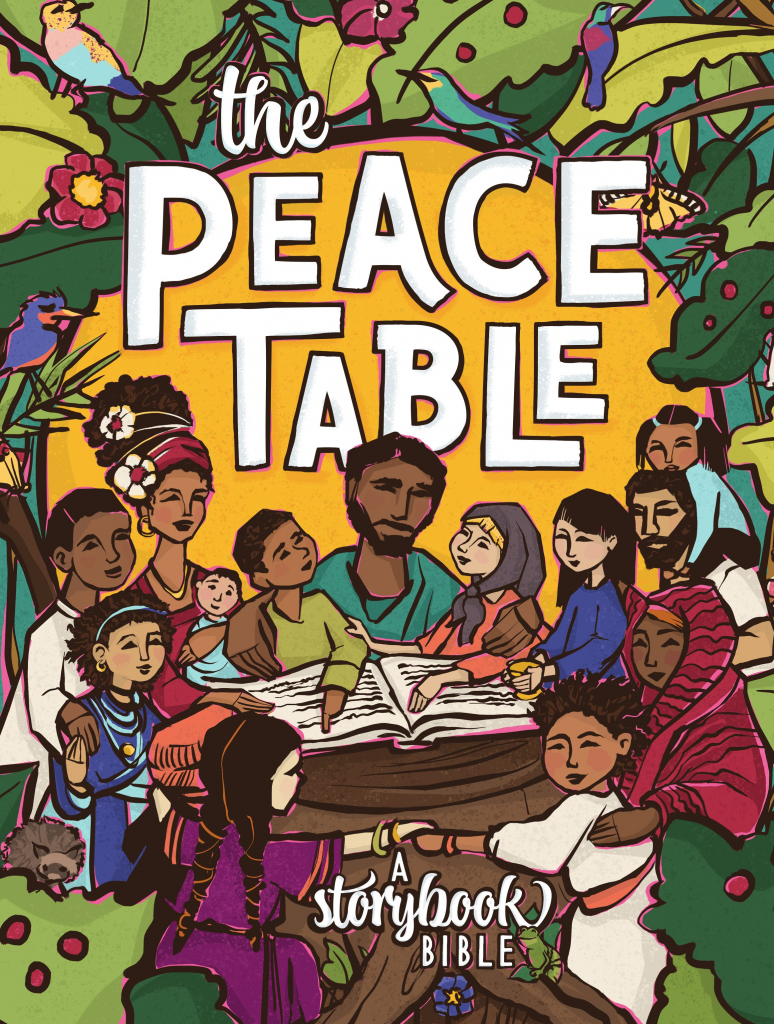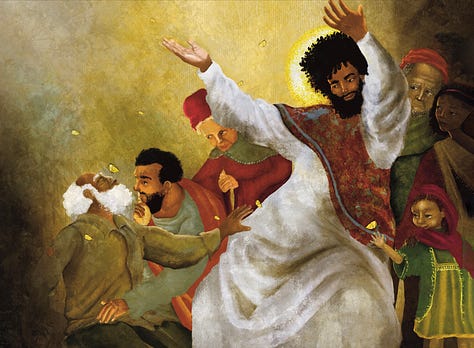I am thrilled to bring you this guest post from friend and colleague, Matthew Peterson, a review of “The Peace Table: A Storybook Bible” from Shine Curriculum. He has done such a good and thorough job that I will not elaborate here except to say, go check it out! To see the original review, visit Matthew’s website here
Finally! A comprehensive, thought-provoking, devotionally-focused Children’s Bible that addresses underrepresented themes. With great illustrations too!

As parents with young children, my wife and I have been on a years-long quest to find quality resources that can help our children develop a strong yet curious faith. We’ve found some resources that are very good. And others that are good yet targeted to different settings than the home. There are also some that offer a good format but uncritically teach one perspective on secondary theological issues. And then there are others that are just down right terrible (and which I will not mention by name).
Yet even after filtering out much of the nonsense that passes for children’s faith literature, I am often frustrated by some recurring trends in the genre. Even among resources that teach sound theology there is a tendency to oversimplify the Scriptures into basic moralizing – be kind to people, avoid lying, etc. Such principles are important but oftentimes wind up derived from stories in which they are hardly the center of attention.
And while abstract moral principles can lead to good behavior, they lose their grounding when taught in isolation from the biblical storyline. It is not enough to simply teach that certain behaviors are right/wrong, as behaviors at their core stem from worldviews rather than isolated commands. Jesus does not simply tell his followers to not kill, he tells them to love their enemies because that is the way in which he lived his own life in service to God the Father.
Particularly irksome for me is the tendency to take challenging texts and turn them “cute” so that the kids pay attention. The cliche example here the story of Noah and the Ark, the subject of many nursery room lamps, pop up books, and Little People figures. Children love images of happy little boats stuffed with smiling giraffes and elephants. That is quite far from the actual narrative, which, taken at face value, contains a catastrophic flood that kills most of the world’s people and animals. It also skips over the important theme of that narrative: whether God desires to respond to extreme human violence with a violence of his own.
In a similar vein, I have observed a tendency to completely skip over portions of the Scriptures that are morally complex. David is presented solely as the hero who killed a giant rather than a deeply flawed individual. And from many volumes one would think that the book of Joshua contained only a truncated version of the account about Rahab.
Finally, literature targeted to the mass-market of the Christian subculture tends to gloss over important issues that might be controversial in some circles. Jesus’s teachings unambiguously command a non-retaliatory posture towards others. Yet because that posture conflicts with the militarism that exists across much of American evangelicalism, his teachings are diminished to be about sharing at the playground or not being a bully. Those are both good things for children to learn but not the end goal of the Sermon on the Mount.
With all of these factors in mind, when I saw that Herald Press was producing The Peace Table: A Storybook Bible, I placed a pre-order with minimal hesitation. Herald Press is a publishing house associated with the Anabaptist/Mennonite traditions that publishes quality books addressing all manner of issues from the Anabaptist worldview. I have purchased several resources from them in the past and have found each of them to be genuinely engaging. Might a new Children’s Bible produced by Herald likewise be helpful? In my use of The Peace Table over the past month, I have found it to be so. In fact, I have found it to be a comprehensive, thought-provoking, devotionally-focused Children’s Bible that addresses underrepresented themes. All this, with great illustrations too!
Contents Overview
Readers with knowledge of other Children’s Bibles will find much familiar (and much refreshing) within the pages of The Peace Table. The bulk of the book is comprised of simplified 1-4 page long versions of various Bible stories accompanied by pictures in various art styles. All the highlights are there, from the early stories of Genesis, through God’s redemptive work in the Exodus and among the early Israelites, through the monarchies, prophets and exile. New Testament stories are dominated by the Gospels, with a whopping sixty-three entries across the four Gospels, followed by excerpts from Acts, the epistles, and Revelation. A few epistles are missing, most notably the curious lack of the book of Hebrews, but otherwise all the bases are covered. The Gospel-heavy balance is expected given the book’s Anabaptist leanings.

I have found the writing style in The Peace Table’s biblical summaries to be refreshing. It tends to be clear without being superficial, and sometimes is even approaching poetic. Also appreciated is the inclusion of direct quotes from the Scriptures rather than solely relying on summarization. This tactic is especially fruitful in the sections taken from the Old Testament prophets, whose writings were filled with intense pathos and which have not found their equal in modern renderings.
I note as well that the artwork was designed by multiple artists from different backgrounds and in different mediums. This approach has the advantage of keeping the visuals fresh throughout the book. It also results in more of a multicultural lens for the imagery. Gone (well, “less prominent”) is the generic Anglo-American Jesus, replaced by portrayals of Jesus and other biblical figures in all sorts of cultural settings depending on the artist. Just look at these examples:
The editors’ comments on the importance of diverse portraits of biblical figures help to situate this important approach in terms of its benefit to children:
“Some of the illustrations may be different than you expect. Several are illustrated in settings around the world. This is not to suggest that the actual events happened in Indonesia, Mexico, Malaysia, or Canada. Rather, it is an invitation to imagine the how timeless and universal message of the Bible lives and breathes in our own families, churches, communities, and around the world. … It is our prayer that when children see these varied representations of Jesus, they will more easily recognize the image of God within themselves and each other.”
The Peace Table, page 14
I suspect that most readers (like myself) will be initially attracted to The Peace Table on the basis of this artwork. And, truthfully, it continues to be a joy to open up several weeks later in large part thanks to its stunning visuals. But I think that where this resource truly shines is in its devotional components. Over the years I have found myself confused by how little input or engagement is demanded in children’s religious literature. Many resources, including good ones like The Jesus Storybook Bible by Sally Lloyd-Jones, simply provide a story to be read aloud and then move on. Sometimes you might find a craft recommendation or rarely a topic to pray about. But sorely lacking in many resources is any direct engagement with the thought and emotional lives that children lead. Children may lack the vocabulary to describe the divinity of Jesus or may have trouble recalling the names of ancient kings, but they are not entirely passive beings who should be read at. In my own experience, I know of few people more genuinely inquisitive than children – and I am surrounded by academics!
I am happy to report that The Peace Table contains quality devotional materials that engage children’s thoughts and emotions with each of its 140 stories. Children are challenged to Wonder & Share in response to questions like “How would you feel if, like Joseph, you were in prison for something you did not do?” and “What emotions would you feel if you were walking between two walls of water?” They are prompted to Pray about situations in their own lives or in the lives of others that might be brought up by the story. In some cases this second component includes a prayer practice like practicing the Shema or drawing a scene while they pray. Each of the stories is also tagged with a Peace Path note or other activity for children to practice genuine peacemaking in their lives. The Peace Paths are a system of interconnected stories centered around the following themes:
- Peace with God
- Peace Inside
- Peace with Others
- Peace with Creation
Readers can find the tagged lists of stories in the preface and the appendix, to build a thematic study for their children, or they be encountered organically when reading in chronological order. I love this element of the book. Peace Path entries ask children to discover and apply principles of non-retaliation, enemy love, and mutuality in their homes, schools, churches, and other settings. For example, the story of the reunification of Jacob and Esau contains the following entry:
“It was not just Jacob and Esau who made mistakes in this story. What could the parents, Isaac and Rebekah, have done differently? Talk as a family about times you have hurt one another. How can you show that you love each other?”
The Peace Table, page 38.
I can already sense my therapist friends cheering in the metaphorical balconies. This is good devotional material with genuinely transformative opportunities.
The back of the book contains some important historical and geographical information in the form of biblical timelines and maps. But what is most impressive is a nearly twenty page long section of prayer and peace practices. This section introduces children to the practices of praise and lament, confession and intercession. It offers creative ways of engaging in prayer with tactile input such as breath prayers or tracing your finger through a maze while praying for others. Liturgical prayers for various times of day and life events round out the prayer components. The book then revisits the Peace Path themes by providing example practices to implement those themes into your daily routine and phrases to help children give expression to their feelings and to the concepts found throughout the book. These resources are a delightful end to a wonderful book, and have the potential to benefit adults as well as the target audience of their children.
A Few Critiques
So far this review has been quite glowing. But no book is perfect, even those that I wholeheartedly recommend. As with any Children’s Bible, The Peace Table contains some gaps in what materials are covered in its pages. These gaps are less than even some of the other quality Children’s Bibles on the market, yet they are there nonetheless. The book of Joshua appears only once, when that text contains several important narratives. I suspect this might be due to the book’s reputation as an account of a genocide, which is a fair concern. And perhaps the challenges raised by that text for a non-violent posture might be a bit too complex for the target audience.
Isaiah dominates The Peace Table’s excerpts from the Prophets, which makes sense given that book’s importance in the Christian tradition. However, additional stories or teachings from Jeremiah and Ezekiel (which receive one entry each) would have been appreciated. A similar situation occurs in the New Testament, where the Gospels receive dozens of entries each (which is a good approach), but there is curiously not a single entry related to the books of Galatians and Hebrews. I also wish that the Wisdom literature was explored in greater detail. The Peace Table contains only seven Psalms and brief summaries of Proverbs and Song of Songs. This is in fact quite a bit more than the average Children’s Bible (in my recollection, The Jesus Storybook Bible contains only one Psalm), but the Psalms are such a rich collection of emotional literature that more would have been welcome, especially as a potential tool for children to explore how they might vocalize their big feelings to God.
Other than these gaps, I have no major complaints about The Peace Table. Within the scope of what it sets out to accomplish (providing a visually engaging and thematically unified Children’s Bible), it excels beyond any other Children’s Bible that I have encountered. It is, simply put, the highest quality individual resource for children’s faith formation that has graced our home, and I look forward to many more years of use. As a result, it comes highly recommended for use in both the home and in children’s ministries at the church level.
More Information
Copies of The Peace Table can be ordered from the Shine Curriculum website. Shine Curriculum produces children’s devotional literature as part of Menno Media / Herald Press. I am thankful for Herald Press’s permission to share the images and excerpts featured above. Please note that I did not receive any compensation for this review, and that I purchased a personal copy of this resource prior to writing it.
Additional footnote comments available at the original post site here
About the Author
Matthew is a member of Plowshares BIC in Lexington, Ky. and a doctoral student at Asbury Theological Seminary. He currently serves as the theologian-in-residence for the Great Lakes conference of the Brethren in Christ. He is passionate about Jesus, his family, and helping others know God more. You can read more of his work at https://mrptheology.wordpress.com/.

.
FAMILY MOVIE NIGHT

Free Resource from ReFocus Ministry
Movies are great because they tell a story, much like the narrative of Scripture and the parables that Jesus uses to each his disciples. Often in movies, we can find rich plots, interesting characters, and complex moral dilemmas and in those things, we can often find just the right opportunity to share with our kids how we can live out our faith or how God can meet our deepest needs. Capture these moments with our FREE Family Movie Night discipleship guide; simply download the PDF, pick your next movie, and share a meaningful moment together as a family.
ReFocus Coaching and Consulting for Churches
Your journey to connecting generations and building a discipleship community begins here!

Your ReFocus coaching experience begins with a FREE 30-Minute Initial Coaching Call and ends with a congregation connected to one another and their community like never before. Together, you and/or your team will discover the generations in your church, identify the bridges and barriers to intergenerational interaction, and create an action plan to grow your community.

Now Scheduling: Fall/Winter 2023
Christina Embree is the founder and director of ReFocus Ministry. She holds a masters in ministry focused on Children, Youth, and Family Ministry and a doctorate in spiritual formation with a focus on age segregation and intergenerational ministry. In addition to coaching churches of multiple denominations and traditions all around the globe, Christina serves as the Minister of Generational Discipleship for the Great Lakes Conference of the Brethren in Christ and as a pastor at Plowshares Brethren in Christ in Lexington, Kentucky. She is widely recognized as a speaker and author in the areas of generational discipleship, intergenerational ministry, and family ministry. As the mother of three children, she is familiar with the challenges of faith at home and pastoral ministry. She along with her husband Luke share a love for the church, their community, and the global work of peace and restoration through Jesus.


